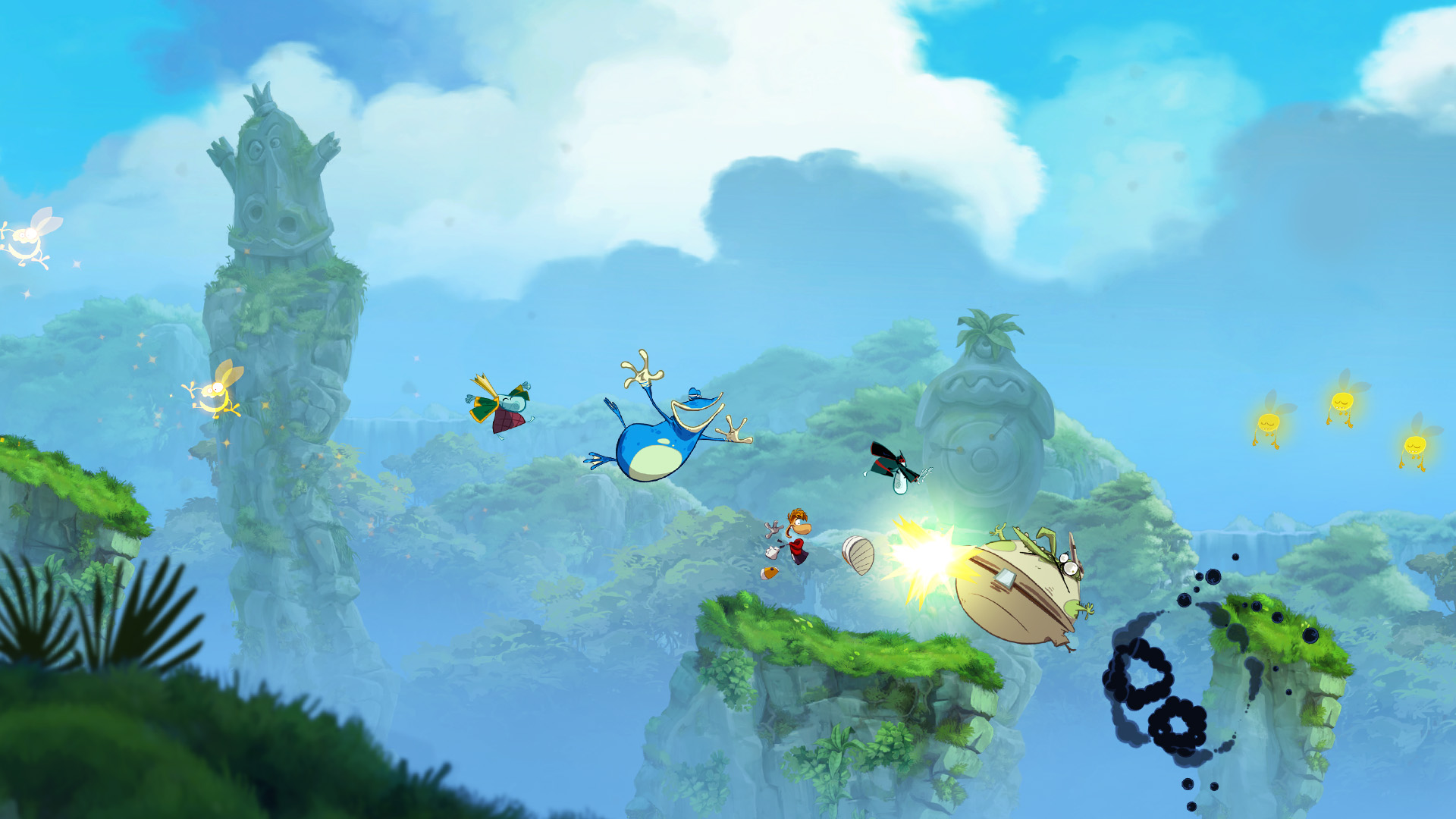GamesRadar+ Verdict
Pros
- +
Lush
- +
hand-drawn visuals
- +
Sublime level design
- +
Satisfying sound effects and music
Cons
- -
Brutal difficultly
- -
Unforgiving action and controls
- -
Chaotic four-player co-op
The visuals alone are enough to lull even the most seasoned gamer into a false sense of security. Vibrant colors abound, preposterous characters gambol and cavort with giddy abandon, and vivacious animation breathes life into the already-fecund levels. But don’t be fooled by Rayman Origins. This intensely beautiful 2D platformer can easily crack open and scramble even the most hardened of hardcore gamers.
And that’s a very good thing.
Despite starring a limbless character, Rayman Origins pulls no punches. In many ways, this is a retro platformer with high-def trappings. Gone are the rubber-cement ledges along with the heroes who can stick landings like a Soviet gymnast during the height of the Cold War. In their place? Momentum. Timing. Precision. And lots and lots and lots of dying. During the eight hours we spent in Rayman Origins’ world, we were constantly on edge, both literally and figuratively. This isn’t one of those relaxing platform adventures we’ve come to enjoy in recent years. This is a lean-forward, pay-the-#^&%-attention-or-else-you-will-die kind of game that left our thumbs sore while reminding us what we love about the genre.
Most impressive: Rayman Origins achieves its gameplay greatness almost entirely through its incredible level-design. The game uses only two buttons – jump/hover (that’s a single-jump only, mind you) and attack – three if you count the shoulder button/trigger, used for running. This isn’t about picking the right move, or the right tool, or the right weapon. Instead, it’s about nailing a tricky leap from lillypad to lillypad with absolutely no margin for error – all while piranha-like fish lurk below and spiky plants linger above. Or, it’s about ever-so-carefully hovering through an obstacle-laden sky, blipping the jump button to hover and drop in perfect harmony, using wind currents to soar ever higher while desperately trying to avoid a sudden plummet to our death. Or, it’s the jaw-clenching challenge of wall-jumping up a series of underground pipes to grab a Lum-granting coin sparkling up above, knowing we’re likely to meet our maker as we negotiate through a gauntlet of enemies on our way back down.
Indeed, we get the impression that every platform, every collectible Lum, every bouncy drum, every floating/dissolving cloud, every prickly Psychlops, every electrified jellyfish, and every hidden Electoon challenge room (more on those in a bit) was perfectly positioned to be just out of reach. We can almost feel the hand of the designer in the gameplay, pushing and pulling and tugging at everything to make it just right. Rayman Origins feels like it was built to tap into a gamer’s Pavlovian response to virtual temptation: Sure, we can finish a level without grabbing all the collectibles, but knowing they’re right there – being able to see the equivalent of the forbidden cookie jar on the proverbial top shelf, just beyond our grasp – helped constantly drive us toward the goal of perfecting each and every level.
Of course, we’re also rewarded for perfection – the better we do, the more we unlock – which makes the pursuit of Lums (those shiny, smiley floating gold orbs) and the hidden Electoons (also smiley, but locked away in chests, hidden in secret rooms) even more enticing. It became an obsession for us to find the hidden rooms in every level, listening closely for the aural clues indicating their proximity. Once found, these rooms offer a discrete puzzle challenge: We have to eliminate all the bad guys before we can open the chest. Simple enough, sure, but the way the devs incorporate the latest gameplay hazards is just astounding, constantly layering in new baddies along with new environmental and jumping puzzles. These were among the most difficult bits in the game, but they elicited an intensely satisfying feeling of accomplishment whenever we nailed a nigh-impossible room after a few dozen gut-wrenching tries (never mind the profuse cursing and ill-advised attempts to twist our controller like a dishrag).
To be sure, some of the occasionally crushing difficulty in Rayman Origins is ameliorated by the game’s lush visuals. And it’s not just the lovingly hand-drawn 2D art. The game is alive with constant feedback: plant-like bulbs burst into climbing-vine platforms, oversized drums offer percussive platforms for high jumps, kettles boil over in hellishly hot kitchens, undersea flora explode with Lums and other treats. The visual feedback is heightened by the aural pleasures on offer here: from the furious strumming of a ukulele to the tinkling of every Lum when captured, the music is in perfect harmony with the on-screen action, completing a joyous feedback loop that helps remind us how much fun we’re having. The game also got a bit more manageable as we came to terms with its somewhat punishing nature; once we learned to not expect Origins to be so forgiving, we began to fully master its limited controls. Soon enough, we found ourselves blasting through segments that had given us fits earlier, including those brutally challenging chase levels that unlock in every world.
Once caveat: Rayman Origins is at its very best as a solo experience. With one player, the camera draws in close enough to see all the action, and it’s much easier to manage the mayhem on screen. As a co-op game, it’s still pretty darn amazing; two players can help each other out, surviving some of the tougher passages in tandem. But with three or more players, it quickly devolves into a manic mess. Get all four players into a single-screen couch co-op game, and Rayman Origins quickly devolves into something to do with your hands while all four of you yell at each other. (Plus, everyone wants to be either Rayman or Globox; no one ever wants to be one of the two Teensies.)
At a time when games seem to offer a whole lot of everything, Rayman Origins stays focused on pure platforming pleasure, and it delivers. Yes, it can be too tough for some, but we’re betting even the more casual players will soon find themselves hopelessly addicted to the finely tuned challenges on offer here. Play it for the love of platforming, or pick it up as a palate cleanser between bouts of this fall’s bigger releases.
More info
| Genre | Platformer |
| Description | The visuals alone are enough to lull even the most seasoned gamer into a false sense of security. Vibrant colors abound, preposterous characters gambol and cavort with giddy abandon, and vivacious animation breathes life into the already-fecund levels. But dont be fooled by Rayman Origins. This intensely beautiful 2D platformer can easily crack open and scramble even the most hardened of hardcore gamers. |
| Platform | "3DS","PC","PS Vita","Xbox 360","PS3","Wii" |
| US censor rating | "Everyone 10+","","Everyone 10+","Everyone 10+","Everyone 10+","Everyone 10+" |
| UK censor rating | "","","","","","" |
| Release date | 1 January 1970 (US), 1 January 1970 (UK) |




